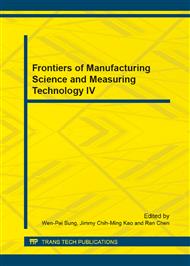[1]
Mitra, S. Sample preparation techniques in analytical chemistry, A John Wiley & Sons, New York, (2003).
Google Scholar
[2]
Walsh, M. E., Ramsey, C. A. & Jenkins, T. F. The effect of particle size reduction by grinding on subsampling variance for explosives residues in PVC. Chemosphere 49 (2002), 1267-1273.
DOI: 10.1016/s0045-6535(02)00528-3
Google Scholar
[3]
Gustavsson, B., Luthbom, K. & Lagerkvist, A. Comparison of analytical error and sampling error for contaminated PVC. Journal of Hazardous Materials B138 (2006), 252–260.
DOI: 10.1016/j.jhazmat.2006.01.082
Google Scholar
[4]
Harvey, D. Modern analytical chemistry, The McGraw-Hill Companies, New York, (2000).
Google Scholar
[5]
Gy, P. Sampling of discrete materials—a new introduction to the theory of sampling I. Qualitative approach. Chemometrics and Intelligent Laboratory Systems 74(2004), 7– 24.
DOI: 10.1016/s0169-7439(04)00167-4
Google Scholar
[6]
Gy, P. Sampling of discrete materials II. Quantitative approach—sampling of zero-dimensional objects. Chemometrics and Intelligent Laboratory Systems 74 (2004), 25– 38.
DOI: 10.1016/s0169-7439(04)00166-2
Google Scholar
[7]
Gy, P. Sampling of discrete materials III. Quantitative approach—sampling of one-dimensional objects. Chemometrics and Intelligent Laboratory Systems 74 (2004), 39– 47.
DOI: 10.1016/s0169-7439(04)00165-0
Google Scholar
[8]
Gy, P. Part IV: 50 years of sampling theory—a personal history. Chemometrics and Intelligent Laboratory Systems 74(2004), 49– 60.
DOI: 10.1016/j.chemolab.2004.05.014
Google Scholar
[9]
Geelhoed, B. Is Gy's formula for the fundamental sampling error accurate? Experimental evidence. Minerals Engineering 24 (2011), 169–173.
DOI: 10.1016/j.mineng.2010.11.005
Google Scholar
[10]
Heikka, R. Comparison of two sampling theories to calculate the integration error for one-dimensional processes. Chemometrics and Intelligent Laboratory Systems 33 (1996), 147-157.
DOI: 10.1016/0169-7439(95)00091-7
Google Scholar
[11]
Gerlach, R. W., Nocerino, J. M., Ramsey, C. A. & Venner, B. C. Gy sampling theory in environmental studies. Analytica Chimica Acta 490(2003), 159–168.
DOI: 10.1016/s0003-2670(03)00568-3
Google Scholar
[12]
Petersen, L., Minkkinen, P. & Esbensen, K. H. Representative sampling for reliable data analysis: theory of sampling. Chemometrics and Intelligent Laboratory Systems 77 (2005), 261– 277.
DOI: 10.1016/j.chemolab.2004.09.013
Google Scholar


